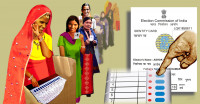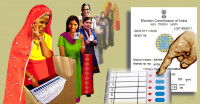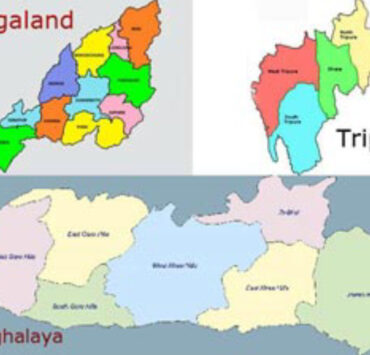
By Swarna Rajagopalan

A procession of Assembly elections in 2017-18 makes it hard to stay caught up with gender analyses of the reportage. In early February, eminent political scientist James Manor published an article in the Economic and Political Weekly about the Karnataka elections. The article does not mention gender, or even women, anywhere.
With so many elections underway and as we already anticipate 2019’s General Elections, it may be useful to take quick stock of scholarship in this field.
Political science, as we know it now, is a field defined in the 20th century, through the lens of Euro-American politics. Democracy is the preferred form of government and elections the most recognisable feature and measure of democracy. Election studies are therefore an established sub-field, and even in India studies, elections are an important area of research.
Stéphanie Tawa Lama-Rewal maps the field of Indian election studies. Typically, she tells us, that election studies focus on “the campaign, the vote, the announcement of results and subsequent government formation” and they may be case studies or survey research. Case studies have tended to be focused on particular constituencies or districts, and offer quite detailed information. While most of them are in political science, she points to sociological and anthropological approaches as well. While electoral surveys were introduced to India by Rajni Kothari and the Centre for the Study of Developing Societies, whose project Lokniti remains at their forefront, psephology was popularised by Prannoy Roy and his colleagues who made news with their projections and analyses.
Since the 1990s, Paul Wallace, Ramashray Roy and colleagues have been putting together analytical volumes after every Indian election. It was only in 2004 that these volumes, usually comprising state-wise chapters, began to have a ‘woman/gender’ chapter, reflecting the extent to which gender has become an important mainstream issue. The first one was written by Sikata Banerjee and the other two by Rainuka Dagar.
Feminist scholars have also been writing about women in politics, and naturally, elections feature. What are feminists who study political science writing about? Mainly inclusion. The what, how many, why and why not of women’s participation in politics is the first concern. This includes women’s entry into politics, their ability to contest elections (having the right, getting nominated), their access to campaign funding, their inclusion in decision-making roles and their career progression. Quotas and their working are a corollary interest, and the International Institute for Democracy and Electoral Assistance (International IDEA) hosts the Gender Quotas Database, which is a terrific resource on the subject. Related to this, feminist scholars also ask why women find it so hard to enter and stay in politics and locate the answer in the prevalence of violence against women in politics. This is a growing research area, and violence against women in elections is an important dimension.
Neither the agenda of inclusion nor the question of violence feature significantly in mainstream election studies as yet. Manor’s article is not an exception.
Why this topic on this blog? Ideally, there should be a conversation between media coverage and academic writing on topics like elections which are anchored in the empirical. Media coverage should provide ‘first information reports’ on real-world trends that scholars pick up and study. Equally, the big picture or historical perspective academics can have should send journalists looking for similar or contrasting stories. But real life either does not allow or does not encourage this synergy, unfortunately. This quick survey with some links may at least lead some of us to explore academic studies a little further whether to be informed by them or to debunk them as irrelevant!




